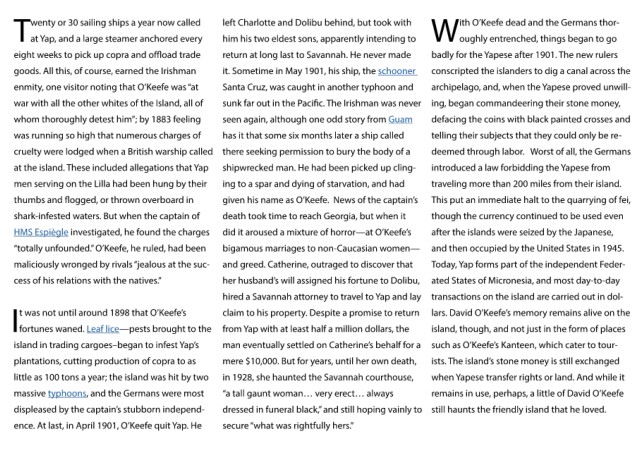Page 316 - Micronesia
P. 316
wenty or 30 sailing ships a year now called left Charlotte and Dolibu behind, but took with ith O’Keefe dead and the Germans thor-
him his two eldest sons, apparently intending to
Tat Yap, and a large steamer anchored every return at long last to Savannah. He never made Woughly entrenched, things began to go
it. Sometime in May 1901, his ship, the schooner
eight weeks to pick up copra and offload trade Santa Cruz, was caught in another typhoon and badly for the Yapese after 1901. The new rulers
goods. All this, of course, earned the Irishman sunk far out in the Pacific. The Irishman was never conscripted the islanders to dig a canal across the
enmity, one visitor noting that O’Keefe was “at seen again, although one odd story from Guam archipelago, and, when the Yapese proved unwill-
war with all the other whites of the Island, all of has it that some six months later a ship called ing, began commandeering their stone money,
whom thoroughly detest him”; by 1883 feeling there seeking permission to bury the body of a defacing the coins with black painted crosses and
was running so high that numerous charges of shipwrecked man. He had been picked up cling- telling their subjects that they could only be re-
cruelty were lodged when a British warship called ing to a spar and dying of starvation, and had deemed through labor. Worst of all, the Germans
at the island. These included allegations that Yap given his name as O’Keefe. News of the captain’s introduced a law forbidding the Yapese from
men serving on the Lilla had been hung by their death took time to reach Georgia, but when it traveling more than 200 miles from their island.
thumbs and flogged, or thrown overboard in did it aroused a mixture of horror—at O’Keefe’s This put an immediate halt to the quarrying of fei,
shark-infested waters. But when the captain of bigamous marriages to non-Caucasian women— though the currency continued to be used even
HMS Espiègle investigated, he found the charges and greed. Catherine, outraged to discover that after the islands were seized by the Japanese,
“totally unfounded.” O’Keefe, he ruled, had been her husband’s will assigned his fortune to Dolibu, and then occupied by the United States in 1945.
maliciously wronged by rivals “jealous at the suc- hired a Savannah attorney to travel to Yap and lay Today, Yap forms part of the independent Feder-
cess of his relations with the natives.” claim to his property. Despite a promise to return ated States of Micronesia, and most day-to-day
from Yap with at least half a million dollars, the transactions on the island are carried out in dol-
It was not until around 1898 that O’Keefe’s man eventually settled on Catherine’s behalf for a lars. David O’Keefe’s memory remains alive on the
fortunes waned. Leaf lice—pests brought to the mere $10,000. But for years, until her own death, island, though, and not just in the form of places
island in trading cargoes–began to infest Yap’s in 1928, she haunted the Savannah courthouse, such as O’Keefe’s Kanteen, which cater to tour-
plantations, cutting production of copra to as “a tall gaunt woman… very erect… always ists. The island’s stone money is still exchanged
little as 100 tons a year; the island was hit by two dressed in funeral black,” and still hoping vainly to when Yapese transfer rights or land. And while it
massive typhoons, and the Germans were most secure “what was rightfully hers.” remains in use, perhaps, a little of David O’Keefe
displeased by the captain’s stubborn independ- still haunts the friendly island that he loved.
ence. At last, in April 1901, O’Keefe quit Yap. He

